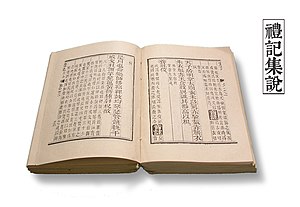Scholia
Scholia(sg.:scholiumorscholion,fromAncient Greek:σχόλιον,"comment", "interpretation" ) aregrammatical,critical, or explanatory comments – original or copied from prior commentaries – which are inserted in the margin of themanuscriptof ancient authors, asglosses.One who writes scholia is ascholiast.The earliest attested use of the word dates to the 1st century BC.[1]
History[edit]

Ancient scholia are important sources of information about many aspects of the ancient world, especially ancientliterary history.The earliest scholia, usually anonymous, date to the 5th or 4th century BC (such as thescholia minorato theIliad). The practice of compiling scholia continued to late Byzantine times, outstanding examples being ArchbishopEustathius' massive commentaries to Homer in the12th centuryand thescholia recentioraofThomas Magister,Demetrius TricliniusandManuel Moschopoulosin the14th.
Scholia were altered by successive copyists and owners of the manuscript, and in some cases, increased to such an extent that there was no longer room for them in the margin, and it became necessary to make them into a separate work. At first, they were taken from one commentary only, and subsequently from several. This is indicated by the repetition of thelemma( "headword" ), or by the use of such phrases as "or thus", "alternatively", "according to some", to introduce different explanations, or by the explicit quotation of different sources.
Important sets of scholia[edit]
Greek[edit]
The most important are those on theHomericIliad,especially those found in the 10th-century manuscripts discovered byVilloisonin 1781 in theBiblioteca MarcianainVenice(see furtherVenetus A,Homeric scholarship), which are based onAristarchusand his school.[2]The scholia onHesiod,Pindar,Sophocles,AristophanesandApollonius Rhodiusare also extremely important.[citation needed]
Latin[edit]
InLatin,the most important are those ofServiusonVirgil;[3]ofAcroandPorphyrioonHorace;[4]and ofDonatusonTerence.[5] Also of interest are the scholia onJuvenalattached to the good manuscript P;[6]while there are also scholia onStatius,[7]especially associated with the nameLactantius Placidus.[8]
List of ancient commentaries[edit]
Some ancient scholia are of sufficient quality and importance to be labelled "commentaries" instead. The existence of a commercial translation is often used to distinguish between "scholia" and "commentaries". The following is a chronological list of ancient commentaries written defined as those for which commercial translations have been made:
- Asconius(c. 55 AD) onCicero'sPro Scauro,In Pisonem,Pro Milone,Pro CornelioandIn Toga Candida
- Servius(c. 400AD) onVirgil'sAeneid
- Macrobius(c. 400AD) onCicero'sDream of Scipio
- Proclus(c. 440AD) onPlato'sParmenidesandTimaeusandEuclid'sElements
- Boethius(c. 520AD) onCicero'sTopics
Other uses[edit]
- Benedict Spinozaprovided his own scholia to many of the propositions in hisEthics,commentaries upon and expansions of the individual propositions, or sometimes short conclusions to sections of argumentation running over a number of propositions.
- In modern mathematics texts, scholia are marginal notes which may amplify a line of reasoning or compare it with proofs given earlier. A famous example isBayes' scholium, in which he presents a justification for assuming acontinuous uniform distributionfor thepriorof the parameter of aBernoulli process.[9]Another famous example of a somewhat different use is to be found inBrook Taylor'sMethodus Incrementorum,in which the propositions demonstrated are often followed by a scholium which further explains the significance of the proposition.
- Scholiais an academic journal in the field ofclassical studies.[10]
- Search engine relying onwikidata,mainly for scientific publications:Scholia.
- Nicolás Gómez Dávilawas one of the most radical critics of modernity whose work consists almost entirely of aphorisms which he called "escolios" ( "glosses" ) of an implicit text.
- In each of Bill Blackbeard'sKrazy KatSunday strip collections, the back of the book includes an Ignatz Mouse Debaffler Page: a page of notes that clarify references that have faded into obscurity or may otherwise require explanation. When a strip has a scholium about it, the lower outer corner of the page is marked with the likeness of Ignatz.
See also[edit]
 The dictionary definition ofscholiumat Wiktionary
The dictionary definition ofscholiumat Wiktionary- Marginalia
References[edit]
Citations[edit]
- ^ CiceroAd Atticum16.7.
- ^J E Sandys,A Dictionary of Classical Antiquities(London 1894) p. 65
- ^J E Sandys,A Dictionary of Classical Antiquities(London 1894) p. 683
- ^A Palmer,The Satires of Horace(London 1920) p. xxxvii
- ^J E Sandys,A Dictionary of Classical Antiquities(London 1894) p. 197
- ^J D Duff,Fourteen Satires of Juvenal(Cambridge 1925) p. xliii
- ^R Sweeny,Prolegomena to an Edition of Scholia on Statius(1969) p. 2-8
- ^H J Rose,A Handbook of Latin Literature(1967) p. 483
- ^Murray, F. H. (February 1930)."Note on a scholium of Bayes".Bulletin of the American Mathematical Society.36(2). American Mathematical Society: 129–132.doi:10.1090/s0002-9904-1930-04907-1.Retrieved3 January2018.
- ^Scholia,ScholiareviewsArchived1 July 2001 at theWayback Machine
Sources[edit]
- Dickey, Eleanor.Ancient Greek Scholarship: A Guide to Finding, Reading, and Understanding Scholia, Commentaries, Lexica, and Grammatical Treatises.Oxford:OUPfor theAPA,2007.ISBN0-19-531293-7.
- Reynolds, L.D. and N.G. Wilson.Scribes & Scholars: a Guide to the Transmission of Greek & Latin Literature,3rd ed. Oxford: Clarendon Press, 1991.ISBN0-19-872146-3.
External links[edit]
This article incorporates text from a publication now in thepublic domain:Chisholm, Hugh,ed. (1911). "Scholium".Encyclopædia Britannica(11th ed.). Cambridge University Press.

